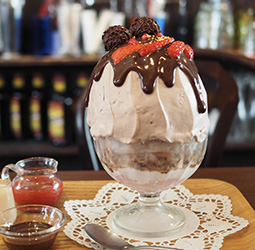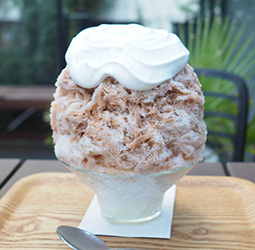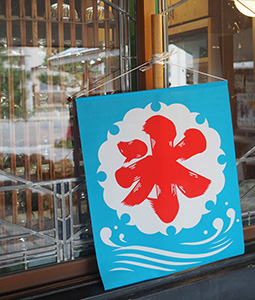INDEX
- English
- 日本語

Kakigori topped with a red, strawberry-flavored syrup - English
- 日本語

Parfait-style kakigori with fresh strawberries

Kakigori made with avocado 
Parfait-style kakigori with chocolate cream and fresh raspberries 
Kakigori with chestnuts and cream 
A banner featuring the character for “ice” advertises kakigori for sale
August 2021
Kakigori: A Sweet Summer Treat

Kakigori, or shaved ice, is a staple Japanese sweet summer treat dating back over a thousand years that continues to evolve with the changing times.

Kakigori topped with sweet syrup is a very popular sweet summer treat in Japan. Recently, that popularity has grown even further as more and more shops offer gorgeous kakigori, including parfait-like versions featuring fluffy, melt-in-your-mouth ice topped with fruits and cream.
“In the last ten years or so, the number of specialty kakigori shops has increased across Japan. As people become more health-conscious, low-sugar kakigori incorporating farm-fresh seasonal fruits or amazake, a fermented rice drink, are also popular. Bowls of kakigori costing over 1,000 yen are not unusual,” says Koike Ryusuke, president of the Japan Kakigori Association.

The electric power shortages in the aftermath of the Great East Japan Earthquake in March 2011 sparked an even greater awareness of energy conservation among the Japanese people as they sought to devise ways to keep cool while reducing power consumption. One thing that became popular at that time was kakigori.
Kakigori has a long history in Japan, dating back to the middle of the Heian period (late eighth to late twelfth century). The oldest known reference to kakigori in existence today is “kezurihi” (shaved ice) in Makura no soshi (The Pillow Book), a collection of observations by Sei Shonagon*, author and a lady at the Imperial Court of Japan. She considered that one of the most elegant things to eat was kakigori placed in a new metal bowl and topped with the sap of the amazura** vine. At that time, ice in summer was a precious commodity that only the privileged class could eat.

“In those days in various locations, such as the modern-day prefectures of Nara and Ishikawa, there were himuro (ice rooms) where ice that formed naturally in winter was stored to prevent it from melting. This simple method relied on caves and holes dug in the ground and insulation with rice straw and other materials, so much of the ice had probably melted by summer. Then from there it was transported to the capital, Kyoto, by which time it would likely have melted and shrunk even more. Still, for the nobility of the time it was a summer treat,” Koike explains.
Kakigori spread to the ordinary people from the Meiji period (1868–1912), when ice-making and ice-shaving machines began to find widespread use. In the summer, shops with banners and noren curtains announcing kori (the character for “ice” in Japanese) appeared on street corners and became a distinctive feature of the season. These banners featuring designs with the character for “ice” are very familiar to people in Japan today. The spread of refrigerators during the period of rapid economic growth in the 1960s and 1970s enabled households to make their own kakigori using simple shaved ice-makers, and at summer festivals, kakigori topped with colorful syrups such as red (strawberry and other flavors) and yellow (lemon and other flavors) became popular among children.

“The ice-making machines which were widely used at restaurants during the period of high economic growth produced small ice cubes, so the blades of the ice-shaving machines hit the ice inconsistently, causing it to break up into granules and resulting in a crunchy texture. Large lumps of ice, on the other hand, can be shaved evenly and thinly, just like shaving wood with a plane, which gives the kakigori the fluffy texture that is popular today,” Koike explains.
Recently, more and more shops are offering new kinds of kakigori that look like Western-style confectionery or finely shaved fluffy ice served with fresh fruits.

In Japan, people enjoy coolness during the hot season with their own favorite kakigori.
* Born in the second half of the 10th century and died in the middle of the first half of the 11th century.
** The amazura vine grew in the mountains and may refer to ivy. Sap from the vine was boiled down to produce a sweet substance.

